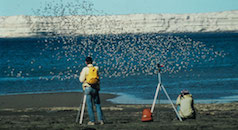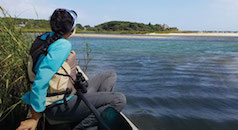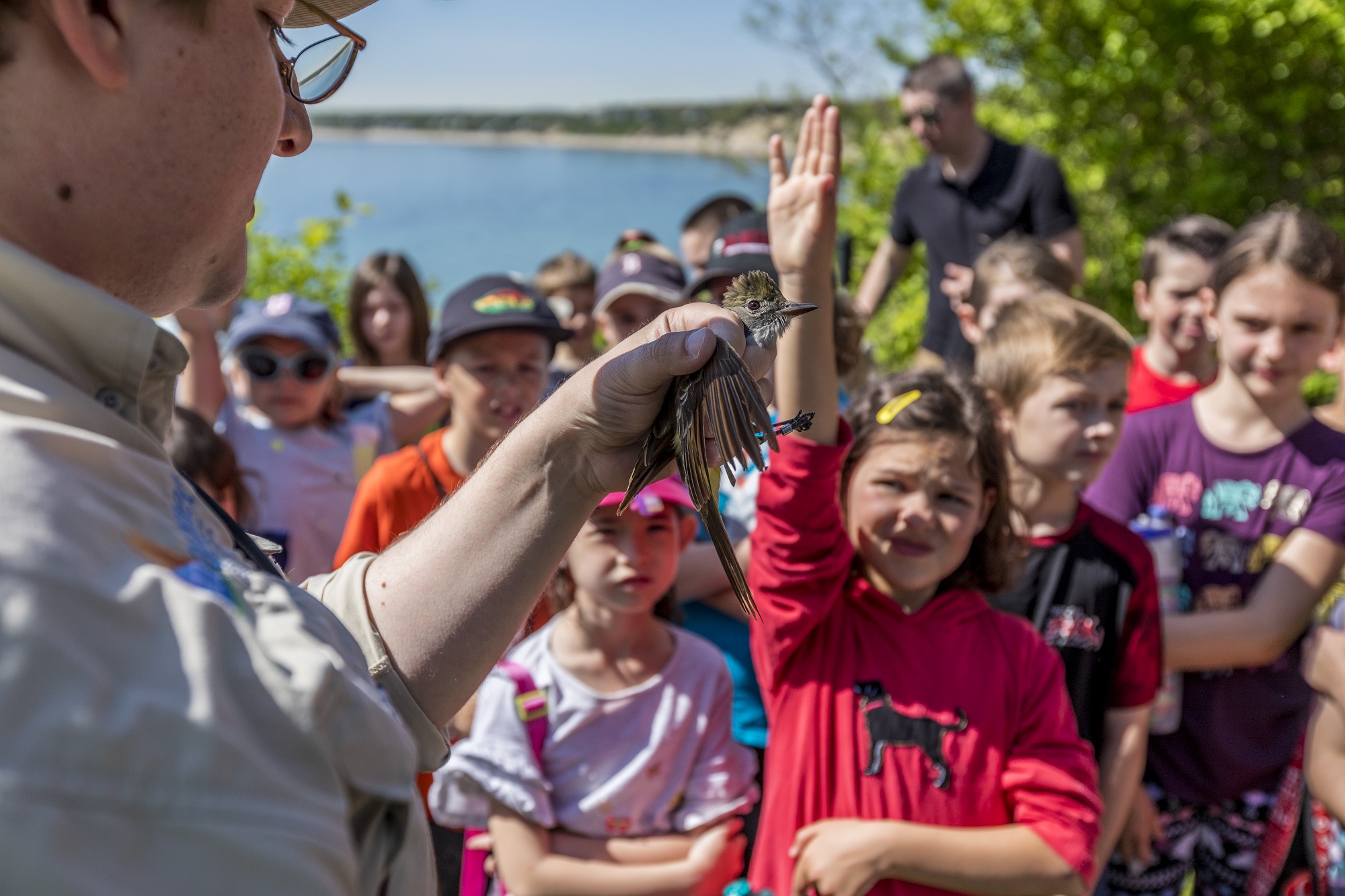Search Results

Interview with Scott Johnston, US Fish and Wildlife
One of Manomet’s core beliefs is that by working in partnership, we can more effectively influence and scale our impact. One key example of this partnership is the Atlantic Flyway Shorebird Initiative (AFSI), led by the US Fish and Wildlife Service (USFWS). Manomet serves on the Executive Committee of AFSI, working closely with Scott Johnston of the USFWS. We had the opportunity to sit down with Scott to get an update on the ASFI business plan and some of his other work. Tell us a little bit about your work at the USFWS. I am the Branch Chief for Populations in the Division of Migratory Birds, US Fish and Wildlife Service, Northeast Region. The Branch of Populations focuses on waterfowl,...
Crabs, Quahogs, and Conservation: Fall Fisheries Update
Over the past few months, Jessie Batchelder, Manomet’s Fisheries Project Manager, has been immersed (quite literally, sometimes!) in vital research focused on protecting critical coastal ecosystems in Casco Bay and beyond. As part of a two-year grant aimed at understanding stressors on eelgrass beds—an area where staggering loss has occurred—Jessie has been working with the Casco Bay Estuary Partnership, Friends of Casco Bay and Team Zostera to understand stressors on eelgrass beds. Manomet’s role in this work has been trapping invasive green crabs to understand population differences in beds of differing status. This season marked the completion of year one, with her team gathering crucial data on green crab abundance and their impact on fragile eelgrass habitats. In addition to...
Aquaculture
Aquaculture is growing in the Gulf of Maine, bringing both opportunities and challenges for coastal communities and ecosystems. Manomet is partnering with shellfish growers to develop opportunities to diversify the species they are growing on their farms, and working with diverse partners to support equitable and thoughtful aquaculture governance in Maine.
New Fishing Opportunities: Invasive, Emerging and Underutilized Species
Fishing communities are being disproportionately impacted by climate change and are incredibly vulnerable in the Gulf of Maine where there is low diversity of fisheries resources and limited access to those resources. We are working to develop new fishing opportunities that support resilient coastal communities and ecosystems by targeting invasive, emerging, and underutilized species.
Paul Dobbins
Paul Dobbins is the Vice President, Low Trophic Aquaculture, and the Senior Director, Impact Investments, at World Wildlife Fund (WWF-US.) He joined WWF to lead the global project, “Advancing Seaweed and Shellfish Aquaculture for Climate Change.” Paul provides thought leadership and financial expertise on how seaweed and shellfish aquaculture can be scaled for increased biomass production and excess nutrient remediation. A former shellfish and seaweed farmer, Paul led the development of the United States’ first open-ocean commercial kelp farms. Prior to returning to the ocean, he was a Managing Director at IDEXX Laboratories, a publicly traded provider of products and services for animal health. Earlier in his career, Paul participated in the funding, growth, and sale of several consumer products...
Understanding the rise of blue crabs in the Gulf of Maine
The Gulf of Maine's warming waters are making conditions just right for this historically mid-Atlantic resident to set up shop. How will their emergence affect Maine's fishing industry, and what are community members doing to help scientists measure their impact? By Rafeed Hussain Beautiful. Savory. Swimmer. That’s what the scientific name for Atlantic blue crabs aptly translates to. These delectable decapods are quintessential to the fabric of the mid-Atlantic seafood scene, culture, and economy. In fact, about half of all blue crabs sold in the U.S. come from Chesapeake Bay. But climate change may be redefining what’s considered home territory for blue crabs—and for the North Atlantic fishing communities whose livelihoods depend on the Gulf of Maine ecosystem. “Historically, outside...
Boosting coastal resilience with shorebirds
Rather than armoring our coastlines, we should help people and shorebirds alike by turning to living shorelines to strengthen resilience to sea level rise and extreme weather events By James Lowen Setting his throne on the seashore, Canute the Great commanded the incoming tide to halt. He knew it would not. The 11th-century King of England, Denmark and Norway – whose name is today carried by Red Knot (Calidris canutus) – was illustrating the limits of human power when faced with the mighty elements. Let all men see, he reportedly beseeched, how empty and worthless is the power of kings. A millennium later, as people and wildlife living along coastlines are swamped by rising seas and battered by intense storms,...
Manomet and partners receive NOAA funding for outdoor learning and climate literacy in Brockton
One of nine projects funded by NOAA’s Environmental Literacy Program, the new Brockton Kids Lead the Way initiative aims to foster city students’ connection to nature. BROCKTON, MA — This fall, Manomet, Wildlands Trust, and Brockton Public Schools will launch Brockton Kids Lead the Way, an ambitious education initiative designed to boost climate resilience and environmental stewardship in the city of Brockton, Massachusetts. This work is made possible thanks to the National Oceanic and Atmospheric Administration's (NOAA) Environmental Literacy Program and is one of nine projects chosen to receive funding to advance climate resilience through education in the U.S. this year. Manomet and its partners will use the funding to design and build outdoor learning spaces in collaboration with teachers...
Why New England’s coastlines are especially vulnerable to climate change
By Emily Renaud All of Earth’s natural systems will be impacted by our rapidly warming climate, but some habitats–the natural homes where animals, plants, and other organisms live–are more vulnerable to the effects of climate change than others. A recent climate vulnerability assessment, published in PLOS ONE, is the first report of its kind aimed at determining which habitats in the Northeast are most likely to feel the worst effects. Take, for instance, the Gulf of Maine. It’s a highly diverse and productive marine ecosystem, with coastal waters teeming with biodiversity, but it's warming faster than 99 percent of the world's oceans. The Gulf of Maine is getting hotter, quickly, and that's changing the population dynamics of the region's species...
Emily Farr
Emily joined Manomet’s Fisheries team in October 2021. She is focused on supporting local fisheries leaders and communities in diversifying fishing opportunities, strengthening adaptive management, and building collaborative networks. Before joining Manomet, Emily worked for the NOAA Fisheries Office of Habitat Conservation, where she collaborated with partners to integrate climate and ecosystem information into fisheries management. Previously, she worked with Maine Center for Coastal Fisheries researching fishery diversification. She has milked goats in Vermont, worked on seaweed and shellfish aquaculture research in Connecticut, and written about food policy for Edible magazine. Emily received a Master of Environmental Management from the Yale School of the Environment, and a Master in food systems from the University of Gastronomic Sciences in Italy.



